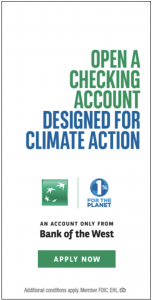Are you doing enough to communicate your bank’s climate policy?
ESG (environmental, social and governance) related topics have been rising in the public consciousness in recent years.
Climate action in particular is taking on new urgency as the impacts of global warming are being felt in all parts of the world. Just this summer, Europe experienced one of the most devastating heat waves in its history. Meanwhile in the U.S., catastrophic wildfires, flooding, drought and super storms have become the norm.
As the climate crisis grows more urgent, consumers are holding the companies they do business with — including their financial institutions — to account. According to a study by Bank of the West*, more than 70% of consumers consider themselves “passionate” about climate change. In addition, a majority of financial consumers, including 70% of Gen Z consumers, would choose to switch their banking relationship because of environmentally harmful financing practices.
In response to this increased public awareness, government scrutiny is growing as well. The SEC recently proposed a new rule requiring banks to disclose their carbon footprints. And the FDIC has published for comment a Statement of Principles for Climate-Related Financial Risk Management for Large Financial Institutions, which is intended to improve the identification and management of climate-related financial risks at banks with $100 billion in assets and above.
Shareholders are also demanding action, spurring climate-aware corporations such as Google, Meta and Amazon to transfer their banking relationships based on the institution’s climate impacts.
As major corporations, regulators and the general public demand greater responsibility from banks, banks must start developing and implementing a climate impact strategy (if they haven’t done so already). Investment and funding of the fossil fuel industry is fast becoming an albatross for lenders, and will have long-term reputational and financial impacts on these organizations. In fact, recent surveys suggest that banks are at risk of losing customers over the issue, such as this 2021 poll from Market Forces that claims the UK mega-banks Barclays and HSBC could lose a combined 3 million customers over their continued investment in fossil fuel companies. The pressure is being particularly felt among younger generations, who are particularly passionate about ESG topics, including climate impact policy.
In response to the increasing scrutiny, a group of big banks including Bank of America, Wells Fargo and Royal Bank of Canada recently formed a consortium to develop standards for measurement and management of climate-related risks.
On the flip side, it’s been shown that financial institutions can have a material and positive impact on climate change by reducing or eliminating their financing of firms in the fossil fuel and other environmentally negative industries, as well as by educating their customers and members and championing environmentally-friendly causes and organizations.
So, how can bank marketers respond to this new reality?
Bank marketers have an important role to play in driving customers’ and the public’s perception of their employers’ climate positions and actions. Although they may not have direct control over their employer’s environmental policies, marketers do have significant influence in crafting messaging, and this is where they can have a major impact. It’s also important to recognize that increasingly, CMOs also have responsibility for revenue growth strategies, particularly if they serve in a dual CMO/CRO role. In such cases, the marketing leader has a natural platform to educate their colleagues on the potential business to be won through climate-positive values and initiatives.
It’s been shown that companies that focus on reducing their environmental impact and are adept at communicating their position publicly enjoy positive bottom-line and reputational results. Nielsen research shows that 48% of U.S. consumers would adjust their purchasing and consumption to lessen their environmental impact. This desire led to $128.5 billion in sales of sustainable products in 2018 alone. And according to McKinsey & Co., firms with high ESG ratings consistently outperform the market over time.
1. Gather the facts to build your climate story
As a marketing leader, it’s important to have a comprehensive view of your institution’s lending and investment policies to be able to effectively communicate them to both internal and external audiences. Begin by digging deep into your corporate policies to uncover potential messages to be highlighted in your marketing.
Has the organization set limits on funding for companies involved in the fossil fuel industry? Has the bank established any metrics or goals for reducing its carbon footprint over time? Does it offset the financing of dirty energy loans via other means, such as offering special, low-interest clean energy loans? These are all prime opportunities for generating positive messages through both earned and paid media.
Once you have uncovered these key elements that define your firm’s position on climate action, encourage your colleagues and senior management to include these nuggets in its mission, vision and corporate value statements.
For example, Clean Energy Credit Union, headquartered in Englewood, Colorado, is an online-only cooperative with a mission “to promote clean energy, environmental stewardship, and cooperative enterprises through the financial services we provide to our members.”
Clean Energy supports its mission by providing clean energy loans that reduce the cost of financing for its members, while decreasing its environmental footprint. It has set a goal of using at least 90% of member deposits solely to fund clean energy loans. The credit union has also committed to reporting its results against this benchmark to its members on an annual basis.
Larger institutions are getting more aggressive on climate as well. TD Bank* was the first major Canadian bank to commit to net-zero emissions by 2050, and recently stopped funding fossil fuel extraction projects in the Arctic. Wells Fargo has also committed to achieving net-zero carbon emissions by 2050 and plans to allocate $500 billion to sustainable financing by 2030.
2. Design products and campaigns targeting climate-conscious consumers
Work with your product development team to identify easy-to-implement products and services that match the values of your most climate-conscious customers or members. Some examples include offering higher loyalty rewards on payment cards for pro-environmental purchases, and debit and credit cards made with upcycled plastic or green materials.
Clean Energy Credit Union offers low-interest clean energy loans, as well as debit cards made from “bio-based, industrially compostable, polylactic acid,” and recycled content paper checks.
In another innovative example, Bank of the West* launched its “1% for the Planet” checking account, which it markets as “a checking account designed to support climate action.” The Bank promises to give back 1% of the net revenue earned from the account to the 1% for the Planet non-profit organization, at no cost to the accountholder.

3. Proactively communicate your results and efforts
Armed with progressive climate action policies and compelling, climate-friendly products and services, marketers can effectively educate consumers and businesses about how their deposits are being used to ensure a sustainable future.
Some ways to do this include:
- Create a CSR (corporate social responsibility) page on your website that shares your institution’s climate policies, goals, initiatives and results.
- Create an annual report focused on climate impacts and carbon footprint reductions.
- Tell your climate action story through your customer or member newsletter.
- Regularly share tips for how customers can reduce their own carbon footprint.
- Create marketing campaigns with an environmental theme and share what your bank is doing to positively impact climate change and support your local community.
- Seek out organizations with climate-conscious goals and membership. Look for innovative ways to support and partner with these organizations through volunteerism, financial support and active promotion of their initiatives and impact.
Don’t underestimate the power of communicating your climate commitment to an engaged and passionate audience. Bank of the West’s “What on Earth?” purpose-driven marketing campaign highlighted its sustainable policies and climate-focused actions. As a result of these efforts, the Bank saw 30% growth in new business.
The movement toward holding financial institutions accountable for their climate impact is real, and it’s not going away anytime soon. Banks and credit unions have an opportunity to get ahead of the trend, by proactively communicating their organization’s climate impact policies and efforts to a now more conscious consumer who is committed to creating a healthy and sustainable planet.
*Disclosure: Bank of the West and TD Bank are clients of McGuffin Creative Group






